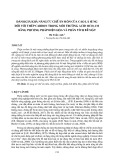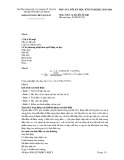
87
https://doi.org/10.52111/qnjs.2022.16306
Tạp chí Khoa học Trường Đại học Quy Nhơn, 2022, 16(3), 87-94
Nghiên cứu lý thuyết cấu trúc và độ bền của
sulfamethoxazole hấp phụ trên bề mặt rutile TiO2 (001)
Ngô Thị Hồng Nhung1, Nguyễn Tiến Trung2, Nguyễn Ngọc Trí2,*
1Khoa Sư phạm, Trường Đại học Quy Nhơn, Việt Nam
2Phòng thí nghiệm Hóa học tính toán và mô phỏng, Khoa Khoa học tự nhiên,
Trường Đại học Quy Nhơn, Việt Nam
Ngày nhận bài:23/03/2022; Ngày nhận đăng: 14/05/2022; Ngày xuất bản: 28/06/2022
TÓM TẮT
Trong những năm gần đây, sự hiểu biết về các quá trình trên bề mặt vật liệu là chủ đề quan tâm đối với các
nhà khoa học. Giai đoạn hấp phụ quan trọng đối với những nhìn nhận xa hơn về các tương tác bề mặt và các phản
ứng quang xúc tác. Trong nghiên cứu này chúng tôi sử dụng các tính toán lý thuyết phiếm hàm mật độ để khảo sát
sự hấp phụ sulfamethoxazole (SMX) trên bề mặt rutile TiO2 (001) (r-TiO2). Các kết quả chỉ ra rằng quá trình SMX
hấp phụ trên r-TiO2 là khá mạnh với năng lượng hấp phụ khoảng -51 kcal.mol-1 thu được tại phiếm hàm vdW-DF2.
Các cấu hình hấp phụ được làm bền chủ yếu bởi các tương tác tĩnh điện giữa nhóm >S=O với các vị trí Ti5f. Bên
cạnh đó, các liên kết hydro kiểu C/N-H...Ob được đánh giá như sự bổ sung quan trọng trong việc làm bền các phức.
Các phân tích AIM và sự chuyển mật độ điện tích khẳng định sự tồn tại và vai trò của các tương tác bề mặt trong
quá trình hấp phụ.
Từ khóa: Sulfamethoxazole, rutile-TiO2 (001), DFT, phiếm hàm vdW.
*Tác giả liên hệ chính.
Email: nguyenngoctri@qnu.edu.vn
TRƯỜNG ĐẠI HỌC QUY NHƠN
KHOA HỌC
TẠP CHÍ

88
QUY NHON UNIVERSITY
SCIENCE
JOURNAL OF
https://doi.org/10.52111/qnjs.2022.16306
Quy Nhon University Journal of Science, 2022, 16(3), 87-94
Theoretical investigation on structure
and stability of sulfamethoxazole adsorbed
on the rutile TiO2 (001) surface
Ngo Thi Hong Nhung1, Nguyen Tien Trung2, Nguyen Ngoc Tri2,*
1Faculty of Pedagogy, Quy Nhon University, Vietnam
2Laboratory of Computational Chemistry and Modelling, Faculty of Natural Sciences,
Quy Nhon University, Vietnam
Received:23/03/2022; Accepted: 14/05/2022; Published: 28/06/2022
ABSTRACT
In recent years, the understanding of processes on material surfaces has drawn considerable interest from
scientists. The adsorption stage is important for further insights into surface interactions and photocatalytic reactions.
In this study, we use density functional theory computations to investigate the adsorption of sulfamethoxazole
(SMX) molecules on the rutile-TiO2 (001) surface (r-TiO2). Results show that the process of SMX adsorbed on
r-TiO2 is quite strong with an adsorption energy of -51 kcal.mol-1 obtained at vdW-DF2 functional. The adsorption
configurations are stabilized mainly by electrostatic interactions between >S=O group and Ti5f sites. Besides, the
C/N-H...Ob hydrogen bonds are evaluated as an important addition in stabilizing complexes. The AIM and charge
density transfer analyses confirm the existence and role of surface interactions in the adsorption process.
Keywords: Sulfamethoxazole, rutile-TiO2 (001), DFT, vdW functional.
* Corresponding author.
Email: nguyenngoctri@qnu.edu.vn
1. INTRODUCTION
Photocatalysts have recently emerged as
attractive interests and are widely applied
in energy, environmental, and health fields
because of their significant properties.
Semiconductor materials were evaluated as an
efficient approach in advanced photocatalytic
processes.1 It is noticeable that TiO2 is one of
the potential candidates and is commonly used
for photocatalysis.2 Besides, the rutile-TiO2
(001) found considerably upon the rutile phase
formation is regarded as a highly reactive,
photocatalytic facet.3-5 However, this facet has
not been wholly investigated about reactions or
interactions on its surface before.
In addition, sulfamethoxazole (SMX)
is a wide-board antibiotic and widely used for
bacterial infections. The existence of their
residues in aquatic environments significantly
affects to life and growth of organisms.6,7 The
removal of polluted compounds is thus paid
more attention by scientists. In previous reports,
materials based on TiO2 were investigated to
remove various organic pollutants, especially
for antibiotics.8-11 Further, adsorption is critical
in complex processes on material surfaces,

89
QUY NHON UNIVERSITY
SCIENCE
JOURNAL OF
https://doi.org/10.52111/qnjs.2022.16306
Quy Nhon University Journal of Science, 2022, 16(3), 87-94
including photocatalysis, sensing, and storage.
Understanding of surface interactions plays an
essential role in evaluating the adsorption ability
and reaction mechanism.12
Recently, computational chemistry
methods have been applied for evaluating and
understanding surface phenomena.13 Using
quantum chemical calculations clarified the
intermolecular interactions between molecules
and material surfaces such as TiO2.14,15
Significantly, including van der Waals forces
in computations provided a better evaluation
of the adsorption ability of molecules on
material surfaces.16 However, the origin and
role of surface interactions between compounds
containing >S=O functional groups such
as sulfamethoxazole (SMX) with material
surfaces, such as rutile-TiO2 (001) facet
(r-TiO2), have not been examined entirely yet.
Hence, in this work, we use quantum chemical
computations to investigate the adsorption of
SMX on r-TiO2 to gain insights into the surface
interactions.
2. COMPUTATIONAL DETAILS
The SMX molecule, r-TiO2 structures, and
adsorption configurations are optimized using
density functional theory (DFT). The vdW-DF2
functional is used to include van der Waals forces
in calculations.17 The kinetic cut-off energy is
set up at 500 eV with a 10-5 eV convergence
index. The Brillouin zone is sampled at the
Gamma center with the k-point mesh of 2 x 2 x 1.
The model slab (a = b = 18.38 Å, c = 30.00 Å) is
designed with a vacuum space of 15 Å to ignore
boundary interactions. The adsorption energy
(EA) is calculated by expression:
EA = EC – EM – ES.
Where EC, EM, ES are energy values of
optimized structures for complexes, SMX
molecule, and r-TiO2, respectively. Besides,
the interaction and deformation energies are
computed as follows:
EI = EC – EM
*
– ES
*; EDM = EM
* – EM; EDS = ES
* – ES.
Here, EI is the interaction energy. EDM and
EDS are deformation energy values for molecule
and surface. EM
* and ES
* are the single-point
energy values of isolated SMX and r-TiO2 in the
optimized complexes. These calculations are
performed by the VASP program.18 Besides, the
characteristics such as molecular electrostatic
potential (MEP) map, deprotonation enthalpy
(DPE), and proton affinity (PA) at sites of
SMX molecule are considered at the B3LYP/6-
31G(d,p) level of theory and carried out by
the Gaussian 09 program.19 The existence and
strength of surface interactions are determined
by the atoms-in-molecules (AIM) theory
and charge density transfers at the B3LYP/6-
31G(d,p) level.20 Moreover, the hydrogen bond
energy (EHB) is computed from electron density
potential (V(r)) through AIM analysis and
followed by the expression: EHB = 0.5 V(r).21
3. RESULTS AND DISCUSSION
3.1. Optimized structures
Performing the optimization of the geometrical
structures, we obtain four stable adsorption
configurations denoted by S1, S2, S3, and S4,
as shown in Figure 1.

90
QUY NHON UNIVERSITY
SCIENCE
JOURNAL OF
https://doi.org/10.52111/qnjs.2022.16306
Quy Nhon University Journal of Science, 2022, 16(3), 87-94
The intermolecular distances of Ti5f...O,
H...Ob contacts are in the ranges of 2.065 - 2.315 Å,
1.680 - 2.697 Å, respectively. These values are
smaller than the total of van der Waals radii of
atoms involved in interactions. The bonding
angels between C/N-H...Ob and S-O...Ti5f
contacts range of 129.75 - 168.23o and 131.11 -
168.26o, respectively. The bond length changes in
forming intermolecular interactions for C/N-H,
S-O are also examined. Accordingly, the bond
elongations of 0.011 - 0.037 Å, 0.033 - 0.049 Å,
and 0.001 - 0.004 Å are found for S-O, N-H, and
C-H bonds. Besides, the adhesion of SMX onto
r-TiO2 is arranged horizontally. The electrostatic
interactions appear at the high negative/
positive charge density sites of >S=O and Ti5f
in configurations similar to recent reports.22
These results are consistent with the formation
of geometrical structures of other molecules
adsorbed on TiO2 surfaces.14-16,22 Consequently,
the stability of adsorption configurations depends
on the Ti5f...O, H...Ob interactions in a horizontal
arrangement of SMX on r-TiO2.
3.2. Energy aspects
The adsorption, interaction, and deformation
energies for the stable configurations and
monomers are observed at vdW-DF2 functional
as gathered in Table 1.
Table 1. The energy aspects of the adsorption
configurations (in kJ.mol-1).
EAEIEDS EDM
S1 -167.3 -215.0 29.9 17.9
S2 -190.4 -237.6 25.7 21.5
S3 -187.7 -220.8 13.9 19.2
S4 -214.4 -247.5 22.7 10.4
The calculated results imply that the Eads,
Eint values are in the range of -167.3 to -214.4,
-215.0 to -247.5 kJ.mol-1, respectively, and
decrease similarly in the order of S1 > S3 > S2
> S4. Therefore, S4 is the most stable complex,
and S1 is the less stable one. It is noted that S4
is stabilized by two Ti5f...O interactions and
C-H...Ob hydrogen bonds while the stability of
S1 is contributed significantly by two Ti5f...O
interactions. The strength of S2 and S3 is based on
one Ti5f...O interaction and N/C-H...Ob hydrogen
bonds. Hence, the stability of complexes mainly
depends on Ti5f...O electrostatic interactions and
the essential addition of C/N-H...Ob hydrogen
bonds. Besides, the adsorption of SMX on the
S3 S4
Figure 1. The stable configurations of adsorption of SMZ on r-TiO2 (distances in Å).
S1 S2

91
QUY NHON UNIVERSITY
SCIENCE
JOURNAL OF
Quy Nhon University Journal of Science, 2022, 16(3), 87-94
https://doi.org/10.52111/qnjs.2022.16306
(001) facet of rutile-TiO2 is slightly weaker than
that for other antibiotics.14 It is due to the horizontal
arrangement of these molecules on TiO2 being
more convenient than SMX. At >C=O, -COOH
groups, the negative charge density is higher than
at >S=O. Consequently, stable intermolecular
contacts are favorably formed in these systems as
compared to SMX-TiO2.
In addition, the deformation energy is
an essential factor in evaluating the interaction
ability and separation of the molecule on the
material surface upon the adsorption process.
Table 1 shows that the deformation energy values
for r-TiO2 (EDS) and SMX (EDM) are ca. 13.9 - 29.9
kJ.mol-1, and 10.4 - 21.5 kJ.mol-1, respectively. It
can be seen that a more considerable change in
geometry of r-TiO2 following the complexation
in comparison to SMX. Calculated results are
similar to rutile-TiO2 (110) surface changes
following the adsorption of molecules containing
functional groups on its surface.14,15,22 Particularly,
the EDS and EDM values of rutile-TiO2 surface and
molecules in these reports are of 10.5 - 56.5 kcal.
mol-1 and 3.3 - 54.0 kJ.mol-1, respectively. Indeed,
the interaction between SMX and r-TiO2 causes
slight changes of the isolated geometries for the
surface and molecule upon complexation.
3.3. Existence and role of surface interactions
3.3.1. MEP analysis and DPE, PA at sites of
molecules
To evaluate the formation ability of intermolecular
interactions, we carried out computations on
characteristics of molecules including MEP
and DPE, PA at sites. The calculated results are
illustrated in Figure 2 and given in Table 2.
Figure 2. The optimized geometry and MEP map of sulfamethoxazole at B3LYP/6-31G(d,p) level (electron
density = 0.02 au; region of -5.10-5 to 0.20 au).
Table 2. The deprotonation energy (DPE) and proton affinity (PA) at bonds and atoms in sulfamethoxazole at
B3LYP/6-31G(d,p) level (all given in kJ.mol-1).
N5-H18 N7-H27 C13-H21 C9-H19 C17-H24 C15-H23
DPE 1482.0 1552.7 1691.2 1689.5 1700.8 1666.5
O3O4O2N6N5N7
PA 888.7 956.0 766.1 977.0 925.9 869.4
The MEP map for sulfamethoxazole
indicates that the O(2,3,4) and N(5,6,7) sites have high
negative electron densities (red color regions).
These sites strongly interact with positive
charge regions at Ti5f on r-TiO2 to form Ti5f...O
attractive electrostatic interactions, especially
at >S=O group. Meanwhile, the significant
positive regions at H atoms (in C-H, N-H bonds)
conveniently interact with the negative charge
sites at Ob lying on the surface to form C/N-H...Ob
stable hydrogen bonds.
As presented in Table 2, the proton affinity
of atoms decreases in the order of N6 > O4(O3) >
N5 > N7 > O2. The electrostatic interactions
between O/N sites with the Ti5f on r-TiO2
are thus stable, especially at N6 and O4 sites.
Besides, the hydrogen bonds formed between
H atoms and Ob on r-TiO2 are more favorable










![Bài giảng Các hiện tượng bề mặt và sự hấp phụ - TS. Trần Phi Hoàng Yến [mới nhất]](https://cdn.tailieu.vn/images/document/thumbnail/2015/20151101/buocchanvva2/135x160/1521446333003.jpg)









![Bộ câu hỏi lý thuyết Vật lý đại cương 2 [chuẩn nhất/mới nhất]](https://cdn.tailieu.vn/images/document/thumbnail/2025/20251003/kimphuong1001/135x160/74511759476041.jpg)
![Bài giảng Vật lý đại cương Chương 4 Học viện Kỹ thuật mật mã [Chuẩn SEO]](https://cdn.tailieu.vn/images/document/thumbnail/2025/20250925/kimphuong1001/135x160/46461758790667.jpg)




